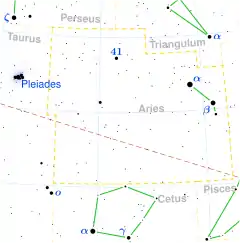Pi Arietis
Pi Arietis, Latinized from π Arietis, is the Bayer designation for a multiple star system in the northern constellation of Aries. Based upon parallax measurements made during the Hipparcos mission, this system is approximately 800 light-years (250 parsecs) distant from Earth and has an apparent visual magnitude of 5.21. This is bright enough to be faintly seen with the naked eye.
 | |
| Observation data Epoch J2000 Equinox J2000 | |
|---|---|
| Constellation | Aries |
| Right ascension | 02h 49m 17.55924s[1] |
| Declination | +17° 27′ 51.5168″[1] |
| Apparent magnitude (V) | 5.21[2] |
| Characteristics | |
| Spectral type | B6 V + A0 V + F8 V[3] |
| U−B color index | –0.47[2] |
| B−V color index | –0.06[2] |
| Astrometry | |
| Radial velocity (Rv) | +8.8[4] km/s |
| Proper motion (μ) | RA: +2.60[1] mas/yr Dec.: –14.10[1] mas/yr |
| Parallax (π) | 4.18 ± 0.69[1] mas |
| Distance | approx. 800 ly (approx. 240 pc) |
| Absolute magnitude (MV) | −1.56[5] |
| Details | |
| Luminosity | 538[5] L☉ |
| Rotational velocity (v sin i) | 70[6] km/s |
| Other designations | |
| Database references | |
| SIMBAD | data |
The primary member of this system is a massive, B-type main sequence star with a stellar classification of B6 V. It is a close spectroscopic binary with an orbital period of 3.854 days, an eccentricity of 0.04, and a combined visual magnitude of 5.30. At an angular separation of 3.28 arcseconds is a magnitude 8.46 A-type main sequence star with a classification of A0 Vp. Finally, a fourth member of the system is a magnitude 11.0 F-type main sequence star with a classification of F8V at an angular separation of 25.2 arcseconds from the primary.[3]
Name
This star, along with δ Ari, ε Ari, ζ Ari, and ρ3 Ari, were Al Bīrūnī's Al Buṭain (ألبطين), the dual of Al Baṭn, the Belly.[8] According to the catalogue of stars in the Technical Memorandum 33-507 - A Reduced Star Catalog Containing 537 Named Stars, Al Buṭain were the title for five stars : δ Ari as Botein, π Ari as Al Buṭain I, ρ3 Ari as Al Buṭain II, ε Ari as Al Buṭain III dan ζ Ari as Al Buṭain IV.[9]
In Chinese, 左更 (Zuǒ Gēng), meaning Official in Charge of the Forest, refers to an asterism consisting of π Arietis, ν Arietis, μ Arietis, ο Arietis and σ Arietis.[10] Consequently, the Chinese name for π Arietis itself is 左更五 (Zuǒ Gēng wu, English: the Fifth Star of Official in Charge of the Forest.)[11]
References
- van Leeuwen, F. (November 2007), "Validation of the new Hipparcos reduction", Astronomy and Astrophysics, 474 (2): 653–664, arXiv:0708.1752, Bibcode:2007A&A...474..653V, doi:10.1051/0004-6361:20078357, S2CID 18759600.
- Crawford, D. L.; Barnes, J. V.; Golson, J. C. (1971), "Four-color, H-beta, and UBV photometry for bright B-type stars in the northern hemisphere", The Astronomical Journal, 76: 1058, Bibcode:1971AJ.....76.1058C, doi:10.1086/111220.
- Eggleton, P. P.; Tokovinin, A. A. (September 2008), "A catalogue of multiplicity among bright stellar systems", Monthly Notices of the Royal Astronomical Society, 389 (2): 869–879, arXiv:0806.2878, Bibcode:2008MNRAS.389..869E, doi:10.1111/j.1365-2966.2008.13596.x, S2CID 14878976.
- Wilson, Ralph Elmer (1953), "General Catalogue of Stellar Radial Velocities", Carnegie Institute Washington D.C. Publication, Washington: Carnegie Institution of Washington, Bibcode:1953GCRV..C......0W.
- Anderson, E.; Francis, Ch. (2012), "XHIP: An extended hipparcos compilation", Astronomy Letters, 38 (5): 331, arXiv:1108.4971, Bibcode:2012AstL...38..331A, doi:10.1134/S1063773712050015, S2CID 119257644.
- Abt, Helmut A.; Levato, Hugo; Grosso, Monica (July 2002), "Rotational Velocities of B Stars", The Astrophysical Journal, 573 (1): 359–365, Bibcode:2002ApJ...573..359A, doi:10.1086/340590.
- "pi. Ari". SIMBAD. Centre de données astronomiques de Strasbourg. Retrieved 2012-08-07.
- Allen, R. H. (1963), Star Names: Their Lore and Meaning (Reprint ed.), New York, NY: Dover Publications Inc, p. 83, ISBN 0-486-21079-0, retrieved 2010-12-12.
- Rhoads, Jack W. (November 15, 1971), "Technical Memorandum 33-507-A Reduced Star Catalog Containing 537 Named Stars" (PDF), Jet Propulsion Laboratory, California Institute of Technology.
- (in Chinese) 中國星座神話, written by 陳久金. Published by 台灣書房出版有限公司, 2005, ISBN 978-986-7332-25-7.
- (in Chinese) AEEA (Activities of Exhibition and Education in Astronomy) 天文教育資訊網 2006 年 5 月 21 日